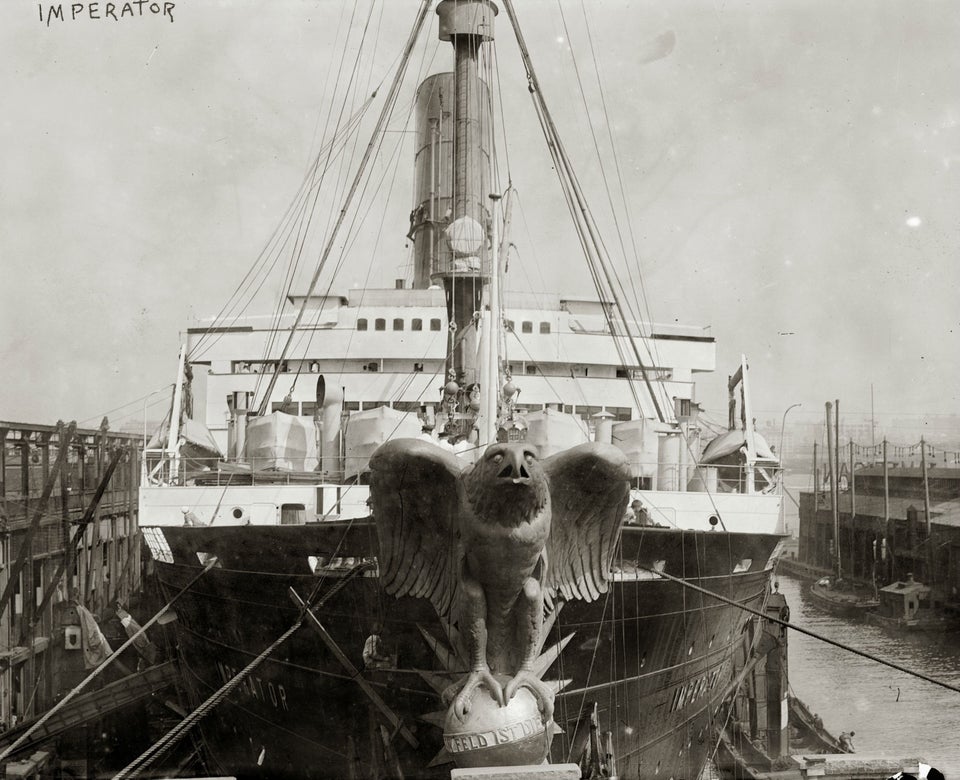A new ocean liner joined the Hamburg-America Line on 23 May 1912: the mighty SS Imperator.
First interesting fact: she was a he. By order of Kaiser Wilhelm II, this ocean liner was only to be referred to with the masculine form, rather than the traditional feminine form used for ships.
The new king of the ocean was even bigger, meaner-looking and more imposing than all those before him. At his bow sat a giant bronze eagle figure with a 16-meter wing span, holding a globe in its claws, with the slogan: “My field is the world.” At the time of its launch, this new ocean liner was described as one of the greatest marvels that the human mind and the human hand had ever created. Swiss journalist Karl Friedrich described the Imperator as “an outrageous giant that has ceased to be a ship, but has become a floating city, an insurmountable bulwark, a monster for which our languages lack the name.

The creator of this magnificent monster was the general director of the Hamburg-Amerika Packetfahrt-Aktien-Gesellschaft (HAPAG for short), Albert Ballin. The Imperator was built in the Hamburg Vulcan shipyard and was the first ship in a new fleet of ocean liners guaranteeing weekly departure from Europe to America. The two other ships of the Imperator class were the Vaterland (launched in 1913) and the Bismarck (launched in 1914). The two younger steamers were built at the Blohm+Voss shipyard, also in Hamburg. The size of the Imperator class ships was only exceeded in 1935, by the famous French ocean liner, the SS Normandie.

At the time of its launch, the Imperator was the largest ship in the world – 268 meters long and 30 meters wide, with enough capacity for 4,234 passengers and 1,180 crew. He was also the first ship to surpass a tonnage of 50,000 GRT.

Ballin astutely decided to leave the speed records to other shipping lines and instead invested in the more meaningful long-term goal of passenger comfort. Building an ocean liner of such size and splendor cost 40 million marks and each mark spent was evident in the luxury on board the Imperator. With one move it left all competition far behind, fighting for second place.

Passengers of the First Class were offered a selection of the finest dishes by internationally renowned chef Auguste Escoffier, whose cookbooks are still widely sought after in present day and auctioned at astronomical prices. The large common areas, such as the restaurant, conservatory and ballroom, were cleverly arranged to be on one deck, leaving passengers with a sense of spaciousness, never experienced before on board a ship. The First Class also offered a Pompeian-style swimming pool, spanning across three decks and clad in marble. An on-board newspaper was published daily in two languages.

But the Imperator only reigned over the North Atlantic for one year, before the First World War broke out. On 8 July 1914, the ship sailed under the HAPAG flag for the last time. With the outbreak of the war, the ship was moored in the Port of Hamburg, where it remained for more than four years.
On 5 May 1919, the Imperator was given to the US Navy as part of Germany’s war reparations to the Alliance. It initially served as a troopship, bringing back a total of 25,000 American troops from France. In 1920, the ship ultimately came under the management of the British Cunard Line and was renamed to Berengaria.

For the first time in six years the Berengaria sailed as a passenger ship. She was under the command of Captain Arthur Henry Rostron, who had previously served on the Carpathia, the ship that famously rescued the survivors of the sinking RMS Titanic. Captain Rostron mentioned the Berengaria in his memoirs as “the most comfortable ship on which he had ever served.” The ship enjoyed great popularity for the next twenty years and carried numerous millionaires, movie stars, great artists, as well as scores of immigrants across the North Atlantic.
See you next week!
The Shipyard

